Girls’ Gymnastic Coach Steven Marion: Training Athletes, Building Character, and Aiding in the Development of Tomorrow’s Woman
By Kaylene Peoples | May 2nd, 2012 | Category: Interviews, Sports | 3 comments “If you’re eating more calories than you’re burning, you’re going to gain weight. If you don’t exercise, it will be weight in fat. If you do exercise, it will be weight in muscles. But as you eat more, does your knee get bigger? Do the ligaments around it get significantly smaller? No. So if you’re coming down on a landing, excessive bulk or weight or excessive amounts of fat (that is weight), your joints are in more danger. It just makes sense to keep your body fat ratio in tow. Because the joints are not going to get any stronger, therefore you’re at double the risk of hurting your joints.” –Training Advice from Girls’ Gymnastics Coach Steven Marion
“If you’re eating more calories than you’re burning, you’re going to gain weight. If you don’t exercise, it will be weight in fat. If you do exercise, it will be weight in muscles. But as you eat more, does your knee get bigger? Do the ligaments around it get significantly smaller? No. So if you’re coming down on a landing, excessive bulk or weight or excessive amounts of fat (that is weight), your joints are in more danger. It just makes sense to keep your body fat ratio in tow. Because the joints are not going to get any stronger, therefore you’re at double the risk of hurting your joints.” –Training Advice from Girls’ Gymnastics Coach Steven Marion
Are you an athlete? If so, most likely you participated in an organized sport in high school. As a young girl, facing challenges relating to competing can be daunting. I for one feel I benefited from playing sports (tennis and track) and as a result have used those experiences to guide me through my adult life. 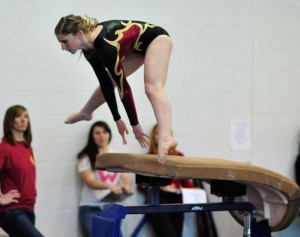 I am the stepmother of a graduating high school senior (Nicole Mouser) who has participated in the sport of girls’ gymnastics. She started her gymnastic career as a sophomore. I have gone through the highs and lows of watching her along with her team compete by attending meets, witnessing victories and defeats, and learning the back stories of the participants of the sport at the award banquets, while listening to her and her teammates’ tearful testimonies about how valuable their experiences were. I was moved when the gymnastics team and we parents rallied around the coach to fight to keep the gymnastics room. The coach’s position was even threatened. The gymnastics team almost lost someone who was so instrumental in leading their team to victory throughout the years, as well as maintaining its legacy. He taught these girls character, watched them graduate, continue their education, and start their own families. Each alumna carries with her experiences that helped to guide her through life. I expect my stepdaughter also to share in those same lessons.
I am the stepmother of a graduating high school senior (Nicole Mouser) who has participated in the sport of girls’ gymnastics. She started her gymnastic career as a sophomore. I have gone through the highs and lows of watching her along with her team compete by attending meets, witnessing victories and defeats, and learning the back stories of the participants of the sport at the award banquets, while listening to her and her teammates’ tearful testimonies about how valuable their experiences were. I was moved when the gymnastics team and we parents rallied around the coach to fight to keep the gymnastics room. The coach’s position was even threatened. The gymnastics team almost lost someone who was so instrumental in leading their team to victory throughout the years, as well as maintaining its legacy. He taught these girls character, watched them graduate, continue their education, and start their own families. Each alumna carries with her experiences that helped to guide her through life. I expect my stepdaughter also to share in those same lessons.
Since 1989, Steven Marion coached sports at Woodrow Wilson High School in Long Beach, CA. I interviewed him about his experiences as a girls’ high school coach and asked him to share the trials, tribulations, and joys of coaching girls through the difficult sport of gymnastics.
Interviewed by Kaylene Peoples (bold)
Responses by Steven Marion
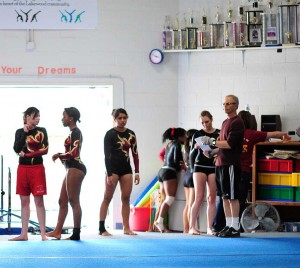 I bet you’ve really seen a lot in regards to women’s gymnastics and women’s sports in general.
I bet you’ve really seen a lot in regards to women’s gymnastics and women’s sports in general.
When I was first in high school, we had 155 high school teams in this area.
Really, that many! What in your opinion as a coach do you attribute that to?
When you look at gymnastics coaching for girls, [it has] grown by leaps and bounds. So why have high school programs diminished in this area when now there are more gymnastic coaches? Obviously girls still want to compete. In my mind it’s because they took the [training] rooms away. After Prop 13 they had to make cuts; and instead of making across-the-board cuts, they looked at sports they could cut so they could put money into other sports. Gymnastics was one of the sports that looked expensive because of the equipment, and it takes up a whole room; and people thought there was a risk factor. When gymnastics is handled properly, the injuries aren’t that significant. For example, when I was at Long Beach State, I did a study on actual injuries treated and actual injuries reported. Gymnastics was sixth and seventh overall—way behind a lot of sports people thought it was going to be ahead of. But I think when it’s instructed and coached progressively (step by step progression) instead of [haphazardly] rabbit out of a hat, the kids are going to see a safer environment, and the injuries aren’t going to be as great.
Tell me about your educational and sports career background.
I started gymnastics out of high school. I went two years at Golden West College and two years at USC.
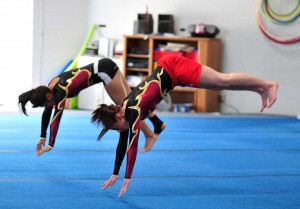 Because of your background and many years of coaching, you’ve become a huge asset to the school. Are there any challenges with coaching girls?
Because of your background and many years of coaching, you’ve become a huge asset to the school. Are there any challenges with coaching girls?
I think not being a girl, you think differently.
What’s the biggest challenge with coaching girls’ high school gymnastics?
I’ve never really thought about it. To me it’s all about getting them through these adolescent years, keeping them off the streets, keeping them from getting pregnant or away from drugs, or giving them reasons to do well in school. As far as the biggest challenge, there are these external influences. I think the economy hurts because kids want to work and help their families (i.e., babysit for siblings). Other than that I think it’s just making kids feel challenged yet making them feel welcome. You have to let them know what they do well and then let them know what they need to do. There is a fine line between not being too critical and too negative and not being too easy on them, too. I think a kid has to enjoy it so they want to keep going. Making her feel encouraged is very important.
I really believe sports are really important anyway because it builds character, you learn to work with other people. You can carry this on into your adult life. I think it’s important to have sports in school and particularly for girls to have some kind of outlet for their athletic skills as well.
It’s about having as many programs for as many kids as you can have. So that as many kids as possible get through this time we call adolescence, get through high school and become functioning citizens and keep this country strong; and also pay my social security when I’m old!
Do you think that girls’ sports are any different now than they were in 1989, especially in regards to disciplines and approaches to the actual sports themselves?
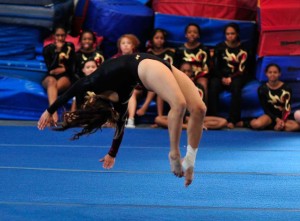 Looking back to how sports were prior to the 70s when they just had the Girls Athletic Association, there was this attitude that “girls don’t want to compete.” That’s ridiculous! Girls want to compete just like anybody else. They sure do. They want to be as competitive as the boys and they like to be part of a team just as much if not more so than boys do.
Looking back to how sports were prior to the 70s when they just had the Girls Athletic Association, there was this attitude that “girls don’t want to compete.” That’s ridiculous! Girls want to compete just like anybody else. They sure do. They want to be as competitive as the boys and they like to be part of a team just as much if not more so than boys do.
The statement that “girls don’t want to compete” is still being said?
It still goes on now behind closed door. As a man I’ll be shot for saying this, but I still hear, “They’re just chicks. Chicks really aren’t athletes anyway.” That still goes on behind closed doors. Our gymnastics room used to be a boys’ gymnastics room. [They tried to take it away recently, but didn’t succeed, thanks to the parents of the girls’ gymnastics team and coach Marion’s efforts to save the room and the sport at Wilson H.S.] The boys’ programs have been eliminated, which I’d love to get started again.
Are some of the girls in your program college bound? Do they look like they will continue the sport in college?
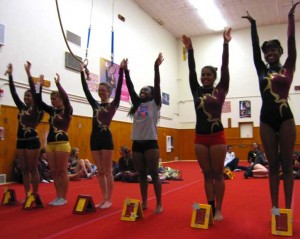 Keep in mind that there are [fewer] than 100 colleges that have a gymnastics team. Look it up on the NCAA and NAIA. In any sport they always push scholarship, scholarship. One percent of the kids are still competing by the time they become a senior in high school. And one percent of those will go to college and compete. And I think something like 10 percent of those will compete all four years. There is a highly limited percentage of kids who go on to participate in college in competitive gymnastics. In answer to that, we have had three kids that have gotten scholarships. There are just so few scholarships being given out.
Keep in mind that there are [fewer] than 100 colleges that have a gymnastics team. Look it up on the NCAA and NAIA. In any sport they always push scholarship, scholarship. One percent of the kids are still competing by the time they become a senior in high school. And one percent of those will go to college and compete. And I think something like 10 percent of those will compete all four years. There is a highly limited percentage of kids who go on to participate in college in competitive gymnastics. In answer to that, we have had three kids that have gotten scholarships. There are just so few scholarships being given out.
Highest High as a Coach
I’ve just enjoyed it my whole life. Just being able to be a part of it all the way through my career, I am one of the lucky ones. It’s nice when you see the kids win. I can’t deny that. I don’t have an individual high point. It’s not about the winning for me. I think there are constant highs when the kids come back and they say “hi” and they’re being successful.
Lowest Low
When I was coaching in Long Beach State and my wife left me. I had planned to be married for life. That was hard for me, and I was so distraught at the time. I felt like the prestige was not worth the pressure of being a college coach, and I left the university. I didn’t realize what I had, and I came back and started teaching at intermediate and high school, and that was a big adjustment. I did not realize how lucky I was to be a college coach at 25 years old.
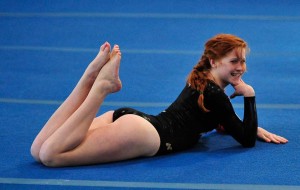 Do you think that maybe the prestige you had as a college coach, you have been able to sustain a girl’s athletic program in high school for as long as you have because of that?
Do you think that maybe the prestige you had as a college coach, you have been able to sustain a girl’s athletic program in high school for as long as you have because of that?
Who knows? When you think about the California State framework, gymnastics are down tumbling because rooms have been averted to weight rooms, fitness centers, etc. That means all kids from first grade to tenth grade should have a floor to participate in gymnastics. I believe in that, but a lot of schools aren’t. It’s an intense unit to teach, but it’s good for kids. The California State’s fitness tests are all based around it. For example, push-ups are a gymnastics exercises, exercises to measure hamstring exercises, back bends, the curl ups (it’s an abdominal thing) . . . They’re all designed around gymnastics. I think it’s just an important activity worthwhile for kids to learn. There’s an old saying, “If you teach a child gymnastics, it will help them in every other activity they’re involved in.” Gymnastics includes every muscle in your body. It uses hand-eye foot-eye reflexes, flexibility, etc. You’ve got it all. Gymnastics is a core activity that needs to be taught and not lost.
There is a lot of childhood obesity. It seems to me that I am seeing heavier girls in sports than when I was in school. How do you handle a situation like that when you have a child who is terribly overweight and she is participating in a sport that is as difficult as gymnastics? Is there something special that you have to do for this child?
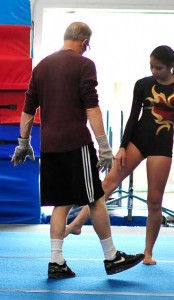 You have to teach the skills by progression. In other words, before they can do B they have to learn A. And before they can do A, they will have to demonstrate a certain amount of strength and flexibility, coordination, agility for physical readiness. So that’s how you handle that. There are skills that are more difficult because they’re hard for them to do them well safely. There are skills that are more difficult they can get hurt on because they’re not doing them so well. You have to make sure the skills you have the kids do are skills that they do not risk serious physical injury.
You have to teach the skills by progression. In other words, before they can do B they have to learn A. And before they can do A, they will have to demonstrate a certain amount of strength and flexibility, coordination, agility for physical readiness. So that’s how you handle that. There are skills that are more difficult because they’re hard for them to do them well safely. There are skills that are more difficult they can get hurt on because they’re not doing them so well. You have to make sure the skills you have the kids do are skills that they do not risk serious physical injury.
You can look at the old fitness tests when gymnastics was discontinued in a lot of the high schools. The physical fitness tests in the California State framework, the scores went down. Kids who participate in gymnastics know they’re going to be turning upside down, rolling, cart wheeling, doing other types of activities whether they’re backbends, back handsprings or front handsprings, depending on their level of skill. So, they eat less because they don’t want to upset their food. This sport really gives them a reason to eat a balanced diet and not overeat before they participate. Plus they know they’re going to be in an outfit that shows more of their body. Having said all of that, you can do all that and there are still some kids who continue to overeat. The worst thing you could do to a child is to put them on a diet. But having said that, we still have to encourage them to eat balanced meals and learn good eating habits.
As a coach what advice would you give to a child that wants to become a gymnast or participate in any other sport?
Go for it. Do it. It doesn’t matter how far you go. It matters what you do when you’re there, how much you love it and how much you learn while going through the process. As an athlete I didn’t get to accomplish the things I wanted to just because I blew my knees out three times. But I still wouldn’t have traded it for the world! The experiences I had, the people I met . . . think of dismounting from the high bar 18 feet in the air, or doing twists with multiple flips. I’m so glad I got to experience those things. I would say don’t be afraid to follow your heart.
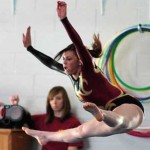
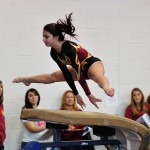
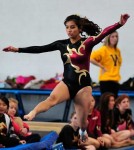
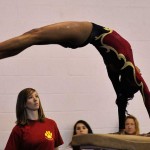









Great article! Mr. Marion is a great coach! He is so inspiring to these children, boys as well as girls. He also coaches surf at Wilson. I am grateful both my son and daughter had the privilege to be in his sports teams. He sends the children a great message and truly cares about each child individually.
I admire these girls for their hard work!
He is a very passionate, athletic coach and trainer but a good insightful developer. He is fit to train for good health and wellness, and he loves to compete, for sure. The Scholastic schools of sports do better than most prestigious school without sports.
I agree with all the problems and his suggestion to lose weight; it is mental training first, and then learn or have a schedule to exercise better along with better eating habits.
We gain 1 to 2 pounds daily with no activity if per day that would amount to much bigger sizes later on in life.loll So he, suggested what you develop in early stages in life with physical sports activity will help build up and sustain us in the areas of self-character, better posture, a better memory and well-being for wellness in life and the list goes on and on. I am from a step-family. My stepfather was my first HERO; he worked his tale off doing construction work as a laborer. My mom is an ex-model, she cooked faithfully for 9 people and she cooked smart. Our stepfather ate so well.
We grew up with him being our example. He was willing to workout with us doing sports, loll.
All and all, most step-families make installments (meaning adjustments) to contribute to the wellness of others in the family. But the main part of this article contributes to the wellness and being in a step-family and how women have advanced, and benefited by wellness in sports and cooperation. Like the coach and his girl athletes, they were the benefactors. They all made out well.